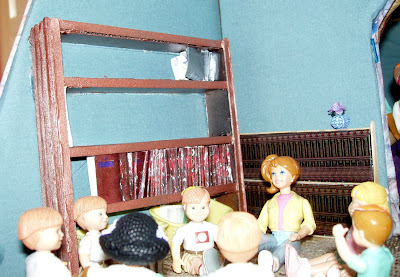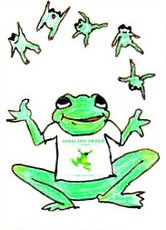Rebuilding the Beit Medrash
 Last summer, at my kids' request, I made a shul (synagogue) for their dolls. It was a hit, and it was enjoyed throughout the year.
Last summer, at my kids' request, I made a shul (synagogue) for their dolls. It was a hit, and it was enjoyed throughout the year.
After a year, however, it needs repair. The girls have been asking me to restore it to its former glory.
Since I have this blog, I plan to document the repairs and replacements as they are made.
Perhaps it will give you some ideas....
The doll shul was elaborate, with many accessories. I snapped a couple of pictures of the building process, but none of the finished product. A few months later, my sister visited, and insisted on taking a few pictures of 'our shul' when she saw the girls playing with it.
Today, a year later, the frame remains in good condition, but the ladies' section and most of the accessories need to be replaced.
The goal was to make a toy synagogue that would stand up to lots of playful abuse:
- I used fancier materials than we normally use for one of our standard doll houses, in order to show honor for the synagogue in the abstract, and for the Torah and its accessories.
- I gave up some of my real beads and fabrics, and spent more time on it than one of my 'normal' dollhouses.
- I wanted there to be room for a at least whole minyan (10 men) of men, and a comparable number of seats for the ladies.
- I wanted the Torah and its accouterments to be somewhat accurate for both educational and play value.
- If an idea resulted in something too fragile or dangerous for play, the idea was discarded, no matter how cute/clever/fun it was.
- I wanted the shul to be a toy that many children could play with at once. I wanted my four daughters and their visiting friends to be able to play simultaneously without having to fight for space.
- I wanted the boxes to be storage-friendly and easily able to move from room to room mid-game.
- This toy had to be sturdy enough to stand up to constant use, by children aged 2-10. (last year.) Thus, I reinforced the edges of the boxes with bits of wood (scavenged from our deck-in-progress' scrap pile) to make the cardboard toddler-resistant. (I think this was successfully achieved: Gretta spent some time inside the shul, and the box didn't cave!)
This is what the finished shul looked like. The men's section is on the left, covered in fabric that looks like brown stones. The main entrance, leading to the social hall on the right, covered in fabric that looks like grey stones. On top of the main entrance, there is the (removable) ladies' section, which is a balcony that overlooks the men's section, when the doorway-arches of the men's section and the front entrance are aligned. There's a pink staircase for the ladies to get to the balcony (far right).
 (In the foreground, there are a few strollers made of Must Gum boxes or broken coat hangers.)
(In the foreground, there are a few strollers made of Must Gum boxes or broken coat hangers.) This is the view from the "East". The flower boxes were made from a lid to a plastic container, each box from one side of it. (See the doll house post for a similar pair of window boxes.) Inside the flowerboxes, a whole cinnamon stick was glued to the back, with whole cloves used as the stems of the paper flowers. I wanted the shul's flowers to smell nice.)
This is the view from the "East". The flower boxes were made from a lid to a plastic container, each box from one side of it. (See the doll house post for a similar pair of window boxes.) Inside the flowerboxes, a whole cinnamon stick was glued to the back, with whole cloves used as the stems of the paper flowers. I wanted the shul's flowers to smell nice.) And this is the view facing "East."
And this is the view facing "East."(The yellow bead is the ner tamid /"Eternal Light" The purple is the reading table. The seven-branched menorah is made from pony beads.)
 The Torah had the first sentence of each of the five books written on it.
The Torah had the first sentence of each of the five books written on it. duct tape and painted or covered with fabric and beads. The breastplate was a Popsicle stick, painted silver and adorned with beads and a chain.
I started with a pair of identical cardboard Amazon boxes. The basic structure involved two boxes and a tray. The first box, held vertically, with the opening on its side, formed the front entrance of the shul and the social hall.
Here are three views of the first box, after it had been cut to shape and the edges were reinforced with painter's masking tape: (No special reason for the blue tape. It was what we had lying around the house.)



On top of the first box, the tray held the ladies' section. The ladies' section is a balcony overlooking the men's section. Since this was on a tray, it could be removed and played with separately.
The second box, held horizontally, with an opening on the top, formed the men's section.
It has four walls and no lid.
The big arch opening is the same size as the arch opening in the first box, so they can line up. It was important to measure this arch on the second box first, and then use it as a guide on the first box. Otherwise, the doorway/entrance to the men's section might have been too big for the box size!

Inside the men's section, there was a built-in bima (stage/dais) and aron (special closet for holding the Torah scrolls.)
Making the Aron, the Amud and the Bimah:
The aron was made from some bits of the cardboard that had been removed from the first box.
This cardboard frame was held together with masking tape. A wooden barbecue skewer was trimmed to size to serve as the curtain rod for the parochet (special curtain that opens and closes on the aron.)

Later, the aron was covered with wooden coffee stirrers. It was painted brown.
A pony-bead was glued to either side of the skewer hole, to help guide the skewer/curtain rod and to keep its ends hidden.
Bits of coffee stirrer were painted to look like two tablets, and they decorated the top of the aron. A crystal bead was glued to the top of it to look like the "eternal light".
The amud (podium) was made by glue-gunning a bit of a coffee stirrer to a sanded piece of scrap wood.
The shulchan (table that holds the Torah when it is being read) was made the same way, but I don't have a close-up picture of it.)

The shape of the bima (platform/stage) was made from bits of egg carton and cardboard. The bima (platform/stage) was reinforced with duct tape and filled with Styrofoam 'clay' to make it sturdy.

Sections of paper towel tube were stuffed with with Styrofoam clay, and then the rest of the volume were filled snugly with more Styrofoam clay. It dried overnight and became solid and firm.

Initially, I made a cardboard tray for the ladies' section. Sometime later, I found a discarded wooden bread tray in our basement, and upgraded to that. It was the perfect size, and very durable. (Not durable enough to have lasted the Winter, though.)
The 'pews' of chairs were made from egg cartons. It turns out, that egg cartons are the PERFECT size to be chairs for 1:12 scale dolls (such as Fisher Price/Playskool Loving Family sized dolls. Fashion Polly dolls can plausibly sit in them, too. One egg forms the seat, a second is the chair base.
This is the top view, with the ladies' section balcony on the left hand side of the picture, and the men's section to the right. The amud is to the far right, at the bottom. There are 14 seats in the men's section and 18 seats in the ladies' section. Here are some of the shul's beta testers.
Here are some of the shul's beta testers.
 Ultimately, the tray/ladies' section was the most popular section, and that is why it no longer exists!
Ultimately, the tray/ladies' section was the most popular section, and that is why it no longer exists!
The ladies section was carpeted with a fabric remnant and decorated with lace, Popsicle sticks, and bits from the egg cartons. (The blue diamonds are painted on the egg carton bits in this
photo:)

 Here is a view from inside the social hall. The dolls are posed in "Groups" (the children's sessions that form during the main shul's Torah service and Rabbi's speech) led by a teenager doll:
Here is a view from inside the social hall. The dolls are posed in "Groups" (the children's sessions that form during the main shul's Torah service and Rabbi's speech) led by a teenager doll: The large (left hand side of picture) bookcase was made from coffee stirrers and painted. It is "built-in" (i.e. glue-gunned to the walls). It is filled with mini-siddurim. We lost all of these, and I plan to replace them, with a tutorial on this blog, soon.
The large (left hand side of picture) bookcase was made from coffee stirrers and painted. It is "built-in" (i.e. glue-gunned to the walls). It is filled with mini-siddurim. We lost all of these, and I plan to replace them, with a tutorial on this blog, soon.
The shorter bookcase (on the right) has a set of non-removable Talmud, clipped from an Artscroll catalog and glued to a piece of foam-core. The "bookcase" was built around it, from coffee stirrers.
There is a bit of a cardboard whiteboard at the front entrance for announcements. That's my sister's handwriting!
 The sign on the staircase says, "Stroller Parking". Just like our real shul, strollers must be left outside. My kids insisted on this!
The sign on the staircase says, "Stroller Parking". Just like our real shul, strollers must be left outside. My kids insisted on this!In fact, they asked for many strollers. We made single strollers, double strollers with front and back seats, double strollers with side-to-side seats, umbrella strollers, carriages....
I made them from broken plastic hangers and Must Gum boxes, mostly. The girls have been asking for more of these, so I hope to have a tutorial in the coming weeks.

So, that is what it was. Over the next few weeks, I hope to re-make/repair the following, while making tutorials so you can, too: (in no particular order)
- Ladies section
- Menorah
- Toy Sefer Torah and its accessories with downloads
- Shulchan (reading table)
- Amud / Shtender (podium)
- Strollers
- Siddurim (prayer books) with downloads
- Parochet and decorations on the Aron (curtain on the closet)
- Generic Dollhouse
- Dollhouse dining room




 We started with three 20"x 30"foam core boards.
We started with three 20"x 30"foam core boards.












































